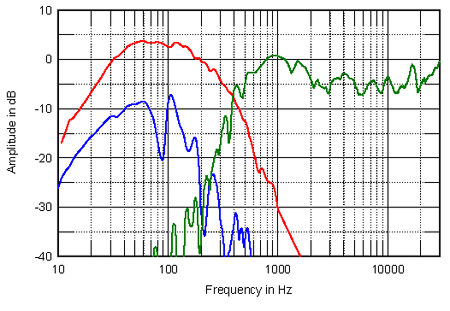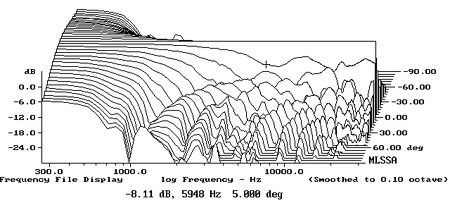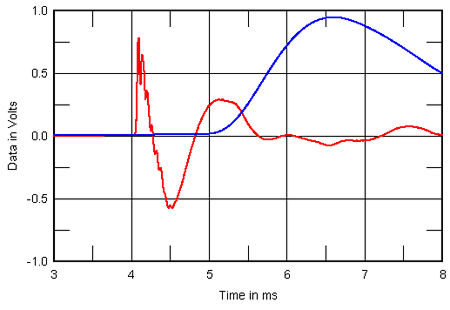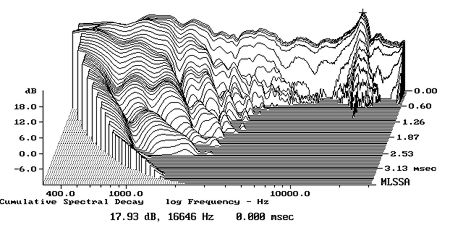| Columns Retired Columns & Blogs |
Innersound Kaya Reference loudspeaker Measurements
Sidebar 3: Measurements
Footnote 1: The Kaya's crossover-amplifier is similar to that provided with the Innersound Eros loudspeaker; see www.Stereophile.com/loudspeakerreviews/819 for its measured performance.—John Atkinson
The Innersound Kaya was more sensitive than I was expecting, at an estimated 89dB/2.83V/m. However, this is way lower than the specified 98dB. Because the woofer and the electrostatic panel are driven by separate amplifiers, I have shown the impedance graphs for each separately. Fig.1 shows that of the panel. It is generally very high, staying above 50 ohms between 225Hz and 1950Hz. However, it plummets in the high treble, reaching a minimum value of 0.5 ohm at 29kHz, which is probably the series resistance of the speaker cable and the internal wiring. There is also an amplifier-punishing combination of 3.3 ohms impedance and a -79 degrees electrical phase angle at 15kHz; both this and the virtual short circuit at 28kHz will lead to problems with amplifiers incapable of sourcing current into these kinds of loads. In addition, the huge variation in impedance in the audioband will give rise to a massive modification of the speaker's frequency response with any amplifier other than a modern solid-state design with a vanishingly low source impedance. Use a classic tube amplifier and the high frequencies will be missing in action!

Fig.1 Innersound Kaya, electrostatic panel, electrical impedance (solid) and phase (dashed). (2 ohms/vertical div.)
Turning to the woofer bin, its impedance magnitude and phase angle are shown in fig.2. Remember, there is no passive crossover; the rise in magnitude above the midrange is therefore due to the voice-coil inductance. Overall, the impedance stays above 4.5 ohms, meaning that the woofer will be fairly easy to drive. Note the single peak at 46Hz, implying that the woofer acts as if it is in a sealed box. The big, rectangular port at the base of the enclosure appears to be the termination of a true transmission line, not a reflex vent.

Fig.2 Innersound Kaya, woofer, electrical impedance (solid) and phase (dashed). (2 ohms/vertical div.)
The wrinkles in the woofer impedance plot are due to cabinet resonances of various kinds. Because the woofer is driven via an external crossover (footnote 1), the higher-frequency modes are unlikely to be excited. However, I did find resonant modes present on all the surfaces, at 172Hz, 240Hz, 340Hz, and 500Hz. Fig.3, for example, shows a waterfall plot calculated from an accelerometer fastened to the center of the sidewall level with the woofer—a fairly strong ridge of delayed energy can be seen at 172Hz. (The woofer was driven by the crossover-amplifier for this measurement, as it would be for music.)

Fig.3 Innersound Kaya, cumulative spectral-decay plot calculated from the output of an accelerometer fastened to the cabinet's side panel level with the woofer (MLS driving voltage to speaker, 7.55V; measurement bandwidth, 2kHz).
The fairly high frequency of 46Hz for the woofer's box tuning frequency would result in a limited low-frequency extension without any equalization. This is shown by the black trace in fig.4, which is the nearfield response of the woofer driven by a conventional power amplifier. Without a low-pass filter, the response extends up to the 1kHz limit of the graph, while in the bass, the woofer starts slowly rolling off below 120Hz, reaching -6dB at 55Hz. The colored traces show the woofer's nearfield response, but now driven with the Innersound crossover-amplifier. The Midrange control, which sets the woofer level, was set to "90," the Bass control first to "0" (the lowest trace, identical to the response without the crossover), then to all the levels from "1" to "12" (top, colored traces). It can be easily seen that the crossover-amplifier both rolls off the midrange—reaching -12dB at 500Hz—and allows the woofer's bass response to be extended down to -6dB at 20Hz. With the usual boundary reinforcement in a typical room, the Kaya's bass extension will reach 20Hz.

Fig.4 Innersound Kaya, nearfield response of woofer without crossover (black) and with crossover bass control set from "0" to "12" (colored traces).
Fig.5 shows the individual responses of the port (blue trace), woofer (red), and electrostatic panel (green), the latter two traces being composites of the nearfield response at low frequencies and the on-axis farfield response at high frequencies. Actually, the large size of the electrostatic panel means that the microphone is not actually in the farfield when placed at my usual measuring distance of 50", which results in the slight downward tilt in the upper midrange that can be seen in the panel's output. Other than that, the Kaya's on-axis output is fairly smooth and flat. The various peaks below the panel's passband are due to the different drumhead resonances of a tautly stretched diaphragm. The fundamental diaphragm resonance lies at 76Hz, but is effectively suppressed by the crossover. It will be excited by the woofer to some extent, and I could hear it coloring my voice when I spoke close to the panel. (This is what Paul Bolin heard when he rapped the speaker's side cheeks.) I wonder if this contributed to the occasional "muddling" Paul noted in his auditioning.

Fig.5 Innersound Kaya, acoustic crossover on center-of-panel axis at 50", with the nearfield responses of the panel (green), woofer (red), and port (blue), weighted in the ratio of the square roots of the radiating areas.
The crossover to the dynamic woofer takes place at 400Hz, though this will be affected by the setting of the Midrange control. With the Bass set to "12," the LF response extends down to the lowest bass. There is no minimum-motion point, confirming that the woofer doesn't act as if it is reflex-loaded. However, there is some output from the port (blue trace), disturbed by slight peaks at the frequencies of the wrinkles in the impedance traces. These are well down in level, however, and shouldn't affect sound quality.
My usual practice is to show a speaker's farfield response averaged across a 30 degrees horizontal angle centered on the listening axis. I have done this for the Kaya in fig.6, which appears to show a catastrophic lack of treble. However, this is almost entirely due to the fact that a large, flat diaphragm becomes extremely directional in the treble, something that is graphically shown in fig.7, the speaker's lateral radiation pattern. Only the differences between the off- and on-axis responses are shown in this graph. Basically, you need to sit within a couple of degrees of the panel's centerline to get a full measure of high frequencies.

Fig.6 Innersound Kaya, anechoic response on center-of-panel axis at 50", averaged across 30 degrees horizontal window and corrected for microphone response, with the complex sum of the nearfield panel, woofer, and port responses, taking into account acoustic phase and distance from the nominal farfield point, plotted below 300Hz. (Panel connected in inverted polarity.)

Fig.7 Innersound Kaya, lateral response family at 50", normalized to response on center-of-panel axis, from back to front: differences in response 90 degrees-5 degrees off-axis, reference response, differences in response 5 degrees-90 degrees off-axis.
In the vertical plane (fig.8), the Kaya's balance doesn't change significantly with listener height, due to its radiation pattern taking on some of the character of a line source. Both this graph and fig.6 were taken with the polarity of the panel inverted, which gave the best frequency-domain integration of the woofer and panel outputs. A crossover suckout develops at extreme high or low positions in this graph; with the same polarity connection, this suckout develops on the listening axis.

Fig.8 Innersound Kaya, vertical response family at 50", normalized to response on center-of-panel axis, from back to front: differences in response 10 degrees-5 degrees above axis, reference response, differences in response 5 degrees-15 degrees below axis. (Panel connected in inverted polarity.)
To investigate why this should be, I plotted the farfield step responses of the woofer and ELS panel separately in fig.9, with both connected in positive acoustic polarity. The panel's step (red trace) features a coherent right-triangle shape, but with some significant lower-frequency ringing present. The blue trace is the woofer step, and it can be clearly seen that its initial rise away from the time axis is opposed by a negative-going section of the panel step's tail. This correlates with the frequency-domain cancellation in the lower midrange on the listening axis.

Fig.9 Innersound Kaya, step response on center-of-panel axis at 50" of electrostatic panel (red) and woofer (blue), both connected in normal polarity (5ms time window, 30kHz bandwidth).
Inverting the panel's output gives the step response of the complete speaker shown in fig.10: the decay of the panel step now smoothly hands over to the start of the woofer's step, which results in better frequency-domain integration of the two units. Whether this is preferred or not will depend on the listening room's acoustic and the height of the listener's chair. I note, however, that PB preferred the Kaya's midrange presentation with the panel and woofer in opposite polarity. Kaya owners should experiment for themselves.

Fig.10 Innersound Kaya, step response on center-of-panel axis at 50", panel connected in inverted polarity (5ms time window, 30kHz bandwidth).
Finally, fig.11 shows the Kaya's cumulative spectral-decay plot, measured in the farfield. Other than a ridge of delayed energy between 16 and 17kHz that coincides with a response peak, the delay of the impulse is much cleaner than I usually find with panel speakers.

Fig.11 Innersound Kaya, cumulative spectral-decay plot at 50" (0.15ms risetime).
Some of the Innersound Kaya's measured behavior is idiosyncratic, but whether or not this will result in audible problems will depend on how the speaker is set up, and whether or not the partnering amplifier can cope with the difficult load. Certainly, in my own auditioning of the speaker at recent shows, I have been very impressed with the accuracy and stability of the imaging and the clean, well-balanced sound—as long as I sat in the sweet spot!—John Atkinson
Footnote 1: The Kaya's crossover-amplifier is similar to that provided with the Innersound Eros loudspeaker; see www.Stereophile.com/loudspeakerreviews/819 for its measured performance.—John Atkinson
- Log in or register to post comments




































